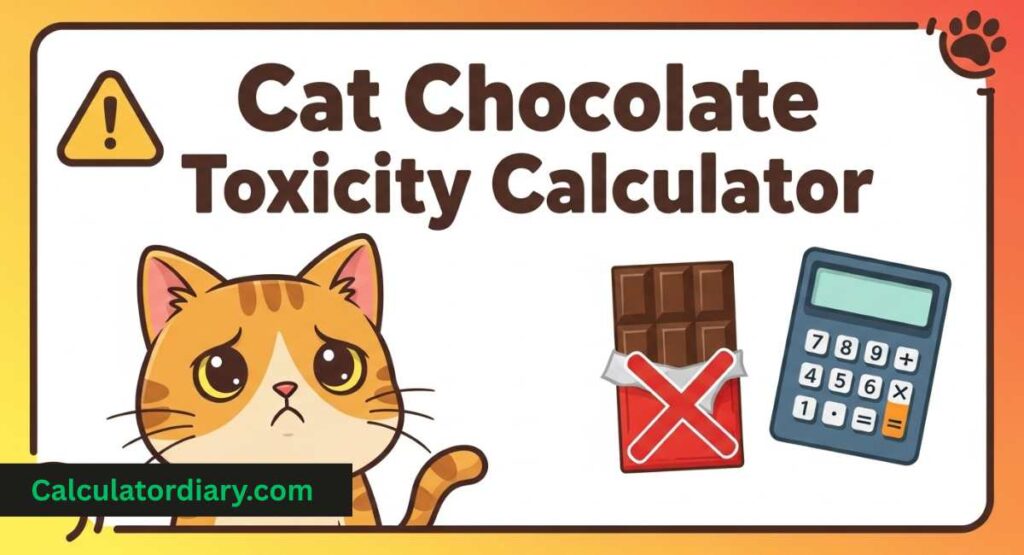That moment of panic when you discover your cat has eaten chocolate is every owner’s nightmare. Chocolate contains toxic compounds—theobromine and caffeine—that cats cannot metabolize effectively. Even a small amount relative to their size can lead to severe medical emergencies, including seizures and cardiac arrest.
Our Cat Chocolate Toxicity Calculator is designed to give you immediate, science-based risk assessment. It is not a substitute for veterinary care, but a critical first step to help you understand the urgency and act accordingly.
How the Cat Chocolate Toxicity Calculator Works
This tool estimates the potential dose of toxic methylxanthines your cat has ingested based on key inputs.
Inputs Required for Accurate Calculation
For the most precise risk assessment, you will need:
- Your Cat’s Weight: In pounds (lbs) or kilograms (kg). Accuracy is critical.
- Type of Chocolate Ingested: The toxicity varies dramatically (e.g., dark vs. white).
- Estimated Amount Consumed: In grams, ounces, or common measurements like “one square.”

The Toxicology Behind the Calculator
The calculator works by estimating the total dose of methylxanthines (theobromine and caffeine) ingested, measured in milligrams per kilogram of your cat’s body weight (mg/kg).
The Formula Logic:Total Methylxanthine Dose (mg/kg) = (Amount of Chocolate (g) × Methylxanthine Content (mg/g)) / Cat's Weight (kg)
For example, baking chocolate has a very high methylxanthine content (~20 mg/g), meaning even a tiny 10-gram piece can deliver a severe dose to a small cat.
Interpreting the Results: What the Dose Means
- Low Dose (< 15 mg/kg): While this range is lower risk, it is not “safe.” Your cat may still experience vomiting or diarrhea. Monitor closely and contact your vet for advice.
- Moderate Dose (15 – 34 mg/kg): This indicates a significant risk of toxicity. Symptoms like restlessness, hyperactivity, and tremors are likely. Contact your veterinarian or an emergency clinic immediately.
- High Dose (> 34 mg/kg): This is a severe, life-threatening emergency. Seizures and heart failure are possible. Do not wait for symptoms. Seek emergency veterinary care now.
Critical Reminder: Regardless of the calculator’s result, if you know or suspect your cat has eaten chocolate, always contact a veterinarian. This tool is for risk assessment, not diagnosis.
Symptoms of Chocolate Toxicity in Cats
Symptoms usually appear within 6-12 hours of ingestion and can escalate quickly. Watch for this progression:
- Early Signs: Vomiting, diarrhea, excessive thirst, panting, or restlessness.
- Worsening Symptoms: Muscle tremors, agitation, rapid heart rate, and elevated body temperature.
- Severe Poisoning: Seizures, rigidity, collapse, and in the worst cases, death.
What To Do If Your Cat Eats Chocolate
- Stay Calm & Assess: Remove your cat from the chocolate and secure any remaining evidence. Note the type and estimate how much was eaten.
- Weigh Your Cat: If you don’t know their exact current weight, weigh them now.
- Use the Calculator: Input the data to get an initial risk level.
- Call Your Vet Immediately: Call your veterinarian or a pet poison helvetica (e.g., ASPCA Animal Poison Control) with the calculated dose and your cat’s symptoms. There is no antidote; treatment is supportive and time-critical.
- Follow Veterinary Instructions: Treatment may include inducing vomiting, administering activated charcoal to prevent further absorption, providing IV fluids, and managing symptoms with medications.
Types of Chocolate and Their Toxicity Levels
The type of chocolate is the single most important factor in determining risk.
| Chocolate Type | Approximate Methylxanthine Content | Toxicity Level & Notes |
|---|---|---|
| White Chocolate | Negligible (≤ 0.1 mg/g) | Very Low Risk. The primary risk is from the fat and sugar, not methylxanthine poisoning. |
| Milk Chocolate | 1.5 – 2.5 mg/g | Moderate Risk. A small amount may only cause GI upset, but a bar can be dangerous for a small cat. |
| Dark Chocolate | 15 – 16 mg/g | High Risk. Highly toxic. Even a small square can be serious for a cat. |
| Baking Chocolate | 20 – 25+ mg/g | Extreme Risk. The most toxic form. A single ounce can be lethal to an average-sized cat. |
| Cocoa Powder | ~20 mg/g | Extreme Risk. Highly concentrated; even a teaspoon can be very dangerous. |
Additional Safety Tips to Prevent Chocolate Toxicity
- Secure Storage: Keep all chocolate products in closed cabinets, well out of your cat’s reach.
- Educate Your Household: Ensure all family members and guests understand that chocolate is poison for cats and should never be offered as a treat.
- Holiday Vigilance: Be extra cautious during holidays like Easter and Halloween when chocolate is more prevalent in the home.
- Save Emergency Numbers: Keep the number for your local emergency vet and the ASPCA Animal Poison Control Center (888-426-4435) saved in your phone.
Conclusion: When in Doubt, Always Call the Vet
Discovering your cat has eaten chocolate is frightening, but quick, informed action can save their life. Our Cat Chocolate Toxicity Calculator is a powerful tool to help you gauge the initial risk, but it is only the first step. Your veterinarian is your most critical partner in ensuring your feline friend’s safety and health.
